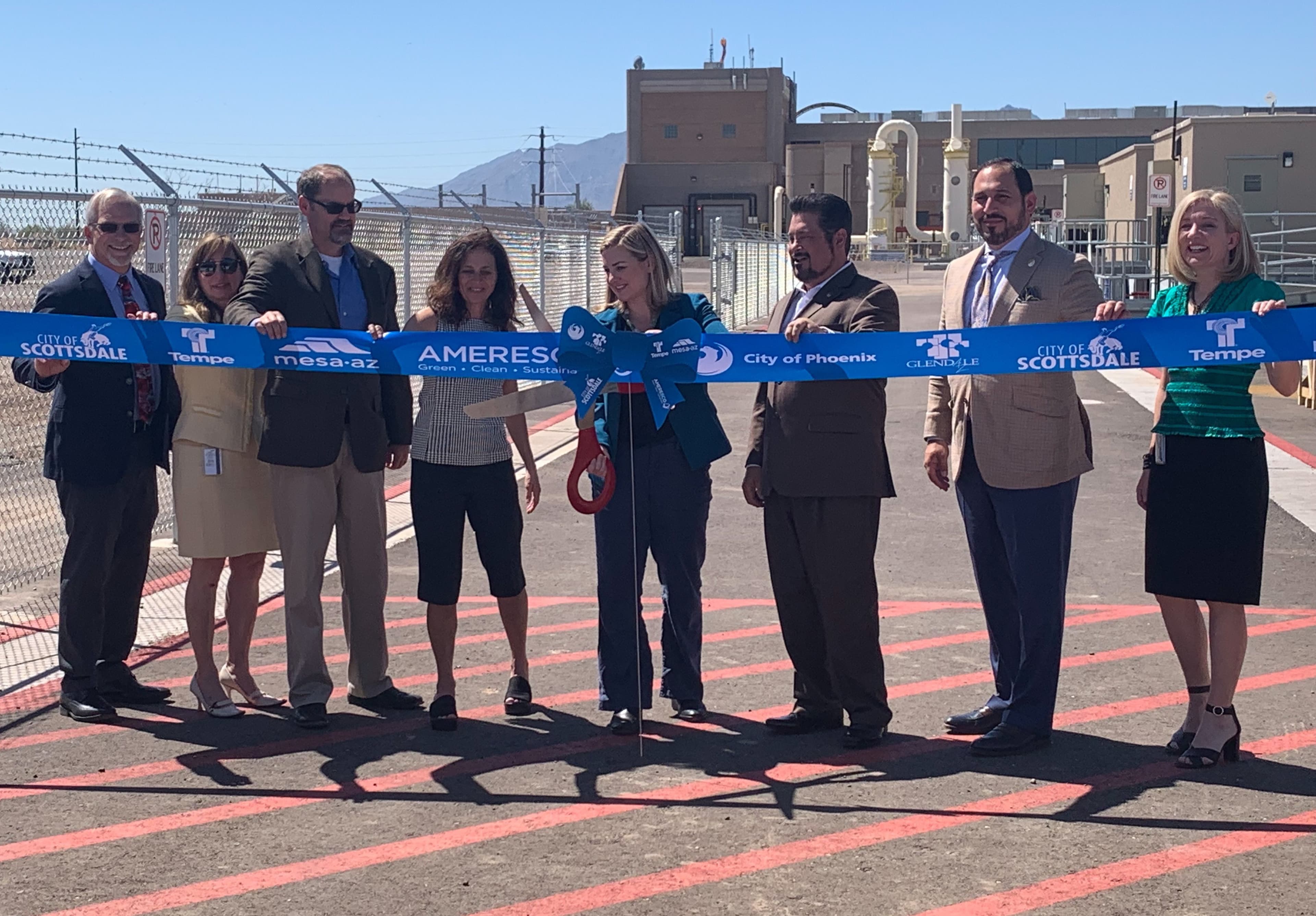AMWUA Blog
BY: Warren TenneyOur Waste at Work

Innovation in wastewater treatment is right under our nose.
Converting waste to energy took a leap into reality last week in Phoenix as Ameresco officially cut the ribbon and unveiled their 91st Ave renewable natural gas (RNG) plant. This plant is the largest facility of its type in the United States and highlights an innovative public-private partnership between Ameresco and the sub-regional operating group (SROG) member cities of Phoenix, Glendale, Mesa, Scottsdale and Tempe, who collectively own the 91st Ave Wastewater Treatment Plant.
facility of its type in the United States and highlights an innovative public-private partnership between Ameresco and the sub-regional operating group (SROG) member cities of Phoenix, Glendale, Mesa, Scottsdale and Tempe, who collectively own the 91st Ave Wastewater Treatment Plant.
With this new RNG plant, located on site at the 91st Ave Wastewater Treatment Plant, recycling wastewater is being taken to the next level. To explain how, we must first look at the reality of what is involved in the processing of wastewater.
All of our wastewater treatment plants strive to run efficiently and work to extract as much recycled water as possible from all the wastewater that flows into those plants. However, we must acknowledge that it is more than water from flushing the toilet, doing laundry or washing dishes that arrives at the plants. There are the solid components which include human waste and the remnants of what was processed through garbage disposals. Although it is not a typical conversation topic, it is our reality and part of the daily routine for the human body.
Wastewater goes down your drains and enters your city’s collection system where gravity and pumps help it flow to a local wastewater treatment plant. With innovation and sustainability as a continual priority for all the AMWUA cities, nearly 100 percent of their treated wastewater is put to use. Cities treat the recycled water to the state’s A+ standard and use it to irrigate sports fields, golf courses, and commercial landscapes. This recycled water also creates riparian habitats and recharge groundwater aquifers for storage underground for use during shortage.
The 91st Avenue Wastewater Treatment Plant is no different. As the largest such plant in the entire Southwest region, it treats an average of 140 million gallons of wastewater a day but has the capacity to treat 230 million gallons. That’s a lot of wastewater. It has been utilizing its effluent, or treated wastewater, to irrigate crops, create a wildlife wetlands project called Tres Rios , and provide water for cooling the Palo Verde Nuclear Generating Station . But what happens with those solids mentioned previously?
Wastewater plants traditionally utilize those solids in a variety of ways. They treat and transform the solid waste into fertilizer for non-food crops, such as hay, alfalfa and cotton. Up until now almost everything the treatment plant took in was recycled except for one thing – the methane gas produced from the solid waste.
All solid waste, human or organic, naturally produces methane, a biogas, as it decomposes. Up to now, that methane has been burned off into the atmosphere. With the new RNG plant, the methane can now be upgraded to natural gas quality standards. Just like wastewater, natural gas is a part of our daily lives as it powers our appliances such as stoves, clothes dryers and hot water heaters. Traditional natural gas is a clean and currently abundant fossil fuel. What distinguishes RNG from fossil natural gas is simply their source - what solid matter is decaying or decomposing? In short, was it yesterday’s dinner or a dinosaur from billions of years ago?
 The new RNG plant also provides an environmental benefit since the methane gas is no longer burned into the atmosphere. By utilizing the biogas, the partners in this initiative are reducing their collective carbon footprint with reduced emissions.
The new RNG plant also provides an environmental benefit since the methane gas is no longer burned into the atmosphere. By utilizing the biogas, the partners in this initiative are reducing their collective carbon footprint with reduced emissions.
Many of those in attendance at the ribbon cutting event last week noted this partnership is part of a broader vision – not only for innovation and sustainability, but to make a difference in carbon reduction and have an environmental impact.
In addition to the environmental benefits, this renewable energy resource will also bring economic benefits to the SROG cities from Ameresco for the purchase of the raw biogas generated at the wastewater treatment plant.
The launching of the new RNG plant is a great celebration of innovation for the cities as this new partnership will ensure the availability of this renewable energy while mitigating methane emissions. This is a win for all, especially considering we all play a part in the wastewater process through our regular contributions.
For 50 years, Arizona Municipal Water Users Association has worked to protect our member cities’ ability to provide assured, safe and sustainable water supplies to their communities. For more water information visit www.amwua.org .
Stay up to date & sign up for the AMWUA Blog:
Sign Up Now For Email Marketing you can trust.
